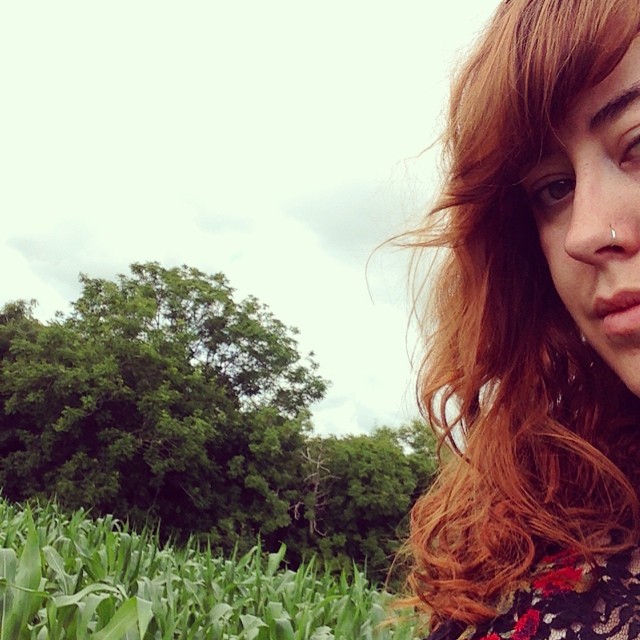41.2 Feature: An Interview with Caroline Crew

Caroline Crew is the author of several chapbooks, including the forthcoming Caroline, Who Will You Pray to Now That You Are Dead (Coconut Books). Her work appears in Conjunctions, Salt Hill Journal, and The Sonora Review, among others. Her full-length collections, Plastic Sonnets, will be out from Big Lucks in 2015. She can be found here: caroline-crew.com
Interview by CONNOR O’NEILL
Black Warrior Review: This essay does a lot of things, one of them being that it demonstrates just a ton of research. How/where do you research? Are there particular eras or figures in history that most interest you?
Caroline Crew: In the last year I’ve been really interested in Christian female mysticism, especially the way in which it’s an expression or a performance in contexts where it isn’t okay for women to express themselves. The idea that gender is performative tends not to look back too far historically, and I find it incredibly satisfying to find examples of subversive gender performance, especially, in the church. I’m not a practicing Christian, but I do believe in the cultural imprint religion has on a person, and I do see myself as irrevocably Christian, culturally. I think my research interests act as a vortex: there’s one main thing I’m reading about, and it’ll send me off in different directions. (Or I will again bemoan that no-one will pay me to name nail polish colours.) Mostly, I’m a library kind of girl, and of course, the miracle of JSTOR and its ilk. A lot of anything that I write begins as marginalia of some kind: pages of direct quotes that gradually my notes encroach upon, and I realise there’s a conversation there.
BWR: You also write poetry, correct? Do you consider yourself primarily poet, essayist and/or is that distinction at all relevant for you? Maybe a better way of asking is: Can you work on both poetry and essays concurrently or does it happen in phases? Have you always done both?
CC: I do! For the longest time, I’ve been a poet and the move into essays is more recent, but there’s very little distinction for me. My focus on female mysticism came from working on a chapbook called CAROLINE, WHO WILL YOU PRAY TO NOW THAT YOU ARE DEAD that created a personal canon of female saints. Writing “No Aperture” pushed me to try and write a longer poem about growing up on a farm in England. So, in a sense they always work together for me. I’ve always enjoyed the research aspect of any writing, and I think being able to display that more clearly in the essay form has given me a sense of understanding as to how to my academic background fits and feeds my writing.
Exploring nonfiction requires certain veils to be redrawn, if not destroyed completely. In that way, I think its probably impossible not to have my other work affected by this kind of interrogation.
BWR: Who are the writers or movements you see your work as being in conversation with? I’m wondering, with regard to “No Aperture”, about Laura Glenum, Ariel Greenberg and the Gurlesque.
CC: Very literally, writing essays has begun as email conversations with poets that I deeply love such as Alexis Pope and Carrie Lorig. I tend to define my work somewhat flippantly as ‘talking to dead women,’ but this is largely true, and so I really do treasure having a very alive girl gang to exchange ideas with. The Gurlesque, too, though, yes! I can’t imagine writing without having that background, those keys offered, a sense of permission to give yourself. I’ve been repeatedly falling in love with Eula Biss’ work, and I think this essay owes a large debt to “The Pain Scale.”
BWR: This essay operates in a few different forms–there’s the personal anecdote as triggering effect, the historical review, and toward the end a doctor’s office questionnaire. Was the germ of the idea for this piece a formal germ or a content germ? Sorry I just said germ so many times.
CC: Ha! I think there were several germs infecting me to get this going. A few years ago I read “The Finger: A Handbook” by Angus Trumble, and that low level obsession with fingernails and manicures has remained steady. Recently, I was asked to write a ‘how I became a writer’ type essay for an anthology, that was my first instance of actually articulating anything about sexual trauma from a personal standpoint. Then, the huge coincidence that my high school English teacher’s son was a member of the Arctic 30, triggering a history with Mary Shelley. I don’t think the formal conceit was a conscious choice as much as an attempted reconstruction of how memory works, how everything is fragmented and patchworked back together in an illusion of coherence. Mainly, I think all of the things at work here have just been around for a long time, and the real germ was timing.
BWR: What are you at work on now?
CC: An essay about skin, taxes, and Scotland, as well as a long poem in some kind of fragments about being a farm girl, and about leaving one’s family. This essay is mainly trying to figure out why I both love and hate the Scots phrase ‘Aw fur coat an nae knickers’ (all fur coat and no knickers.) Often this is an insult levelled at Edinburgh (looks fancy on the outside, but is tarnished and common underneath… as opposed to being honest about it’s common substance, I guess). For example: if one is wearing a fur coat, is that negated by what’s underneath? How exactly do you know what is underneath? I’ve also had some more persona-driven poems on the back burner for a while, also saint driven, but I don’t feel so saintly recently, I suppose.